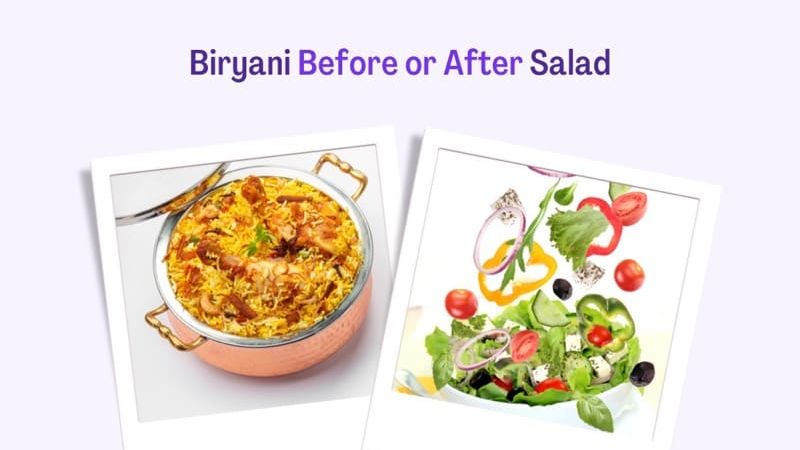

Our Review Process
Our articles undergo extensive medical review by board-certified practitioners to confirm that all factual inferences with respect to medical conditions, symptoms, treatments, and protocols are legitimate, canonical, and adhere to current guidelines and the latest discoveries. Read more.
Our Editorial Team
Shifa Fatima, MSc.
Author
Dr. Apoorva T, MHM.
MEDICAL ADVISOR
Food Sequence Experiment
Components
1. Carbohydrates : Biryani
2. Fiber: Veggie Salad
Experiment Question
Carbs First OR Fiber First?
Experiment Answer
Carbs after Fiber - Have a Salad Bowl before Biryani
A salad before meal helps to slow down gastric emptying. Also, the carbohydrate absorption of the meal consumed after is much lesser, leading to a smaller spike in sugar levels post meal.
Read more about are grapes good for diabetes
Table of Contents
Scientific Rationale
How Does Carbohydrate Metabolism Work?
Any form of carbohydrates has to be broken down into simple units during digestion to derive energy from it. When you consume carbohydrates-containing food, first, the enzymes in your mouth break down the chains of carbohydrates. As the acid in the stomach prevents its further digestion, this food travels to your small intestines, where several enzymes continue your digestion process by breaking down carbohydrates into monosaccharides of glucose or fructose. These simple sugars are absorbed into your bloodstream and travel to different cells, where they are used and stored for energy. This glucose is used for energy, which your body needs for every single function. The amount of energy gained varies with the different foods you eat and how your body digests them. Besides, different forms of carbohydrates affect your metabolism differently.
In a nutshell, this whole process of producing and using energy is called metabolism. And interestingly, every step of carbohydrate (or any other food) digestion also needs energy. After the body exhausts its source of readily available glucose, it burns your fat, followed by muscle, converts it to glucose, and uses it to generate the required energy. So, once the amount of energy your body needs exceeds the amount obtained from the food you consume, you begin to burn stored fat to meet the energy requirements.
Different Forms of Carbohydrates
Carbohydrates are formed with long chains of individual units of simple sugars attached together. The carbohydrate category holds a plethora of different starches, sugars, and fibres, including legumes (beans and pulses), fruits, vegetables (potatoes), dairy, and grains. All these types of carbohydrates are digested differently and impact your metabolism distinctly.
- Monosaccharides: This type comprises single units of sugar like glucose, galactose, and fructose
- Disaccharides: Two linked units of monosaccharides make disaccharides like sucrose (fructose and glucose).
Both the above forms fall into a category of simple carbs that enter our bloodstream almost instantly and can be effortlessly absorbed by our body and used as a source of energy. You burn negligible calories to use these carbs as fuel.
- Polysaccharides: This type of carb is composed of tons of simple units and is predominantly found in starch, grains, vegetables, and legumes. Polysaccharides have to be processed or broken down into simple sugars before they can be soaked into your bloodstream and used by your body. So, your body uses more calories during the digestion of this type of carbs.
- Fibre: It is a type that our human body finds very hard to digest and costs a lot of energy. Fibre intake increases your metabolism by delivering negligible or no energy towards the end of its digestion.
Impact of Low-Carb Diet on Your Metabolism
In a study, which compared the consumption of energy by the individuals on low-carb diets with those on high-carb diets, it was noted that those on a low-carb diet are associated with increased metabolism and burn a lot more energy.
Low-carb diets may help cut down your appetite and prevent fluctuations in your blood glucose levels. Besides, low-carb diets usually contain a high level of protein, which needs more energy for digestion, thereby helping you burn more calories and supporting your weight loss.
However, low-carb diets may not work for all, mainly because your metabolism depends on the quality or types of carbohydrates and your unique physiology. Every human body responds differently to foods containing the exact amount or type of carbohydrate.
Does the Quality of Carbs Matter?
Usually, the foods we eat comprise complex structures that need to be broken down or metabolised by our body to derive the energy stored in them. Some foods (with smaller thermic effects) require less energy to process food, implying your body doesn't have to spend more energy to burn them. While other foods (with larger thermal effects) require more energy to burn, which means your body consumes more calories to process them. So, the quality of carbohydrates matters. For instance, to get the sugar from an apple, our body has to break down its fibrous structure first. In contrast, our body needs no effort if you just eat a spoonful of sugar.
Usually, the more refined or processed (low quality) the food is, the easier it is to digest it. So, precisely, consuming a diet comprising highly-refined carbohydrates like bread or white rice will provide you a lot more energy when compared to consuming the exact amount of carbohydrates from (high quality) sources of legumes, fruits, or whole intact grains.
List of Low GI Foods
We have gone through the glycemic index values of hundreds of foods in this blog post, and we prepared a low GI food list for diabetes. It is also a helpful tool for anyone looking to lose weight or have more energy throughout the day.
What is Glycemic Index?
The glycemic index (GI) is simply a system of eating foods containing carbohydrates. This rating indicates how quickly blood sugar levels will increase when one eats these foods independently. There are two types of GI rating foods, i.e., high GI rated foods and low GI rated foods. Foods with a high GI rating are broken down quickly by your body and rapidly increase blood sugar levels soon after.
Examples of high GI rating foods are:- white bread, potatoes, white rice, etc. Low or medium-GI foods take longer for the body to break down into simple sugars, which results in a gradual rise in blood sugar over time. Examples of low GI rating foods are:- fruits, vegetables, barley, brown rice, etc.
What Constitutes a Low Glycemic Index?
The glycemic index is a concept that essentially measures how much effect the food you eat has on your blood glucose levels. The higher the food's glycemic index, the more pronounced its effect on your body. There are many tables available that list types of foods and their GIs. These tables can give one a greater understanding of what options might be feasible to include in a diet. The GI of a food is considered low when it has a value of 55 or under; high when it has a value of 70 or more; and midrange when it has a value of 56 to 69.
What are the Best Low Glycemic Foods?
1. Oats
A GI score of 55 makes rolled porridge oats a low-GI breakfast option. Oats also contain beta-glucan, a type of fibre with several health benefits. Steel-cut and rolled oats have the best health benefits and the lowest GI scores. Instant and quick oats are more processed and have a higher GI score.
2. Milk
Low-GI dairy products are healthy additions to morning porridge. Skimmed milk has a GI of 37, while full-fat milk has a score of 39. It is a good source of calcium, which supports bone health. Reduced-fat soy milk can have a GI of between 17 and 44, and full-fat soy milk may score 44.
GI scores will vary among brands. But you can also add it to smoothies that contain low GI fruits, such as apples, bananas, grapes, and mangoes.
3. Chickpeas
Chickpeas provide a good amount of protein and fibre per cup, with 11.8 grams and 10.6 grams, respectively; they also contain calcium, potassium, and vitamin B-9. Chickpeas have a low GI score of 28, making them a low-carbohydrate source. Roasted chickpeas make a delicious and fast snack.
4. Carrots
Carrots have a GI score of 39, making them the perfect alternative to bread when enjoying hummus as a dip. They offer a good source of beta-carotene and potassium without the high-fat content of olive oil or dairy cream. These are good for eye health.
Carrots are packed with antioxidants, making them essential to achieving body protection from free radicals.
5. Kidney Beans
The GI score of kidney beans is 24, making them a versatile low-GI food. They are also very high in protein and fibre, with 13.36g and 11g per cup. Kidney beans are also low in fat and high in potassium.
What is the importance of Low GI
The glycemic index provides a classification of carbohydrate-containing foods based on their tendency to elevate your blood sugar levels. Foods with a higher glycemic index will raise your blood sugar significantly faster than those with a lower value. To manage your blood sugar properly, you can apply the basic principles of healthy eating, portion control, and counting carbohydrates.
What are the Benefits of Consuming Food with different Glycemic Indexes?
Low Glycemic Index foods
- Low Glycemic Index foods with a low GI have many means in your quest to lose weight and keep you eating satisfyingly between meals.
- The insulin hormone regulates how much sugar there is in your blood from one meal to another.
- Foods with lower glycemic ratings will help you feel fuller for longer because they will not cause such a sharp spike in blood sugar levels.
High Glycemic Index foods
- Foods that rank high on the glycemic index are easily digested, and they tend to raise our blood sugar more than items lower on that scale would.
- Like carbs with a low glycemic index, foods rich in sugars that rank high on this scale should be avoided by people with diabetes and other medical conditions related to blood glucose levels.
- But these meals can still be taken into account during periods when we need extra power for some vigorous activity (such as exercising) or after suffering from hypoglycemic attacks (when the body has run out of fuel).
What is Glycemic Load, and what is its importance?
The glycemic index (GI) is just one method of analysing carbs. It has become very popular in the past two decades because it is a quick, easy, and cheap measure to process. However, earlier this year, a team of researchers came up with a new system for examining carbohydrates. The combined measurement known as glycemic load (GL) incorporates both the GI and the number of carbohydrates in each food item.
A formula calculates a food's glycemic load (GL).
- To do so, we need to know the glycemic index and how much carbohydrate is in that food in grams.
- The Glycemic index is calculated by multiplying total carbs by the glycemic index, then dividing by 100.
GL = Total no. of Carbohydrates in grams × Glycemic Index (GI) / 100.
Although low-carb diets are highly recommended for better health and weight loss, they may not be advisable or successful for everyone. This is because how these diets impact your metabolism depends on several factors like the type of carbohydrates and how your body works. Some carbohydrates (like fruits, legumes, or whole grains) are difficult to digest and consume more calories to release the inner nutrients.
Likewise, foods containing lots of fibre or complex carbohydrates are those that your body needs to process before they can be used by your body, burning more calories. Such high-quality carbs are always a better choice to lose weight or help maintain your health. On the other hand, foods like refined grains or simple sugars are easy to digest, implying you burn less calories while digesting them. Besides, whether the food increases your metabolism and assists you in losing weight depends on your own unique biology.
Many people with diabetes are interested in lowering their blood sugar after meals. In general, the lower a food's GI, the better it is for you. You can use this low GI food list for diabetes as a guideline to see which foods are best for you. If you are interested in learning more about how the GI of food can help you, feel free to read this blog post.

Disclaimer
This website's content is provided only for educational reasons and is not meant to be a replacement for professional medical advice. Due to individual differences, the reader should contact their physician to decide whether the material is applicable to their case.






_1lAR9W.png)
_Z12iaBn.png)
